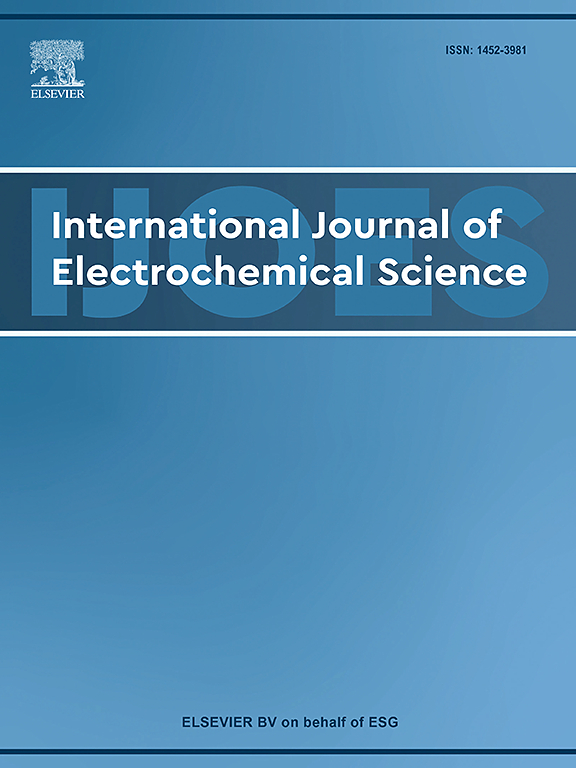Electropolymerized molecularly imprinted electrochemical sensor for sensitive and selective detection of an antipsychotic compound chlorpromazine
IF 2.4
4区 化学
Q4 ELECTROCHEMISTRY
International Journal of Electrochemical Science
Pub Date : 2025-05-21
DOI:10.1016/j.ijoes.2025.101076
引用次数: 0
Abstract
A multi-step fabrication strategy was employed to construct an electrochemical sensor for the selective detection of chlorpromazine hydrochloride (CPZ·HCl), an antipsychotic drug with a narrow therapeutic index. The sensor was developed using a gold-plated glassy carbon electrode, followed by in situ co-electropolymerization of o-phenylenediamine and gold nanoparticles in the presence of CPZ·HCl as a molecular template. The electrode surface was sequentially polished, cleaned, and enhanced with gold deposition, then modified with a nano-molecularly imprinted polymer (nano-MIP) film. After template removal, selective cavities complementary to CPZ·HCl were formed, resulting in a 50 % increase in effective surface area (from 3.6 mm2 to 5.5 mm2). The sensor exhibited a dynamic detection range from 100 pM to 1 μM, with a detection limit as low as 150 fM. It demonstrated a rapid response (∼8 min), high selectivity (ΔI ratio >12 against interfering agents), and excellent reproducibility (RSD <5 %). These findings highlight the potential of the nanoMIP sensor as a robust and cost-effective platform for the trace detection of chlorpromazine hydrochloride in clinical and environmental samples.
用于抗精神病药物氯丙嗪敏感和选择性检测的电聚合分子印迹电化学传感器
采用多步骤制作策略,构建了一种选择性检测治疗指标较窄的抗精神病药物盐酸氯丙嗪(CPZ·HCl)的电化学传感器。该传感器采用镀金玻璃碳电极,在CPZ·HCl作为分子模板存在下,将邻苯二胺和金纳米颗粒原位共电聚合。电极表面经过抛光、清洗和金沉积增强,然后用纳米分子印迹聚合物(nano-MIP)膜进行修饰。模板去除后,形成与CPZ·HCl互补的选择性空腔,导致有效表面积增加50% %(从3.6 mm2增加到5.5 mm2)。该传感器的动态检测范围为100 pM ~ 1 μM,检测限低至150 fM。该方法具有快速反应(~ 8 min)、高选择性(对干扰剂的选择性为ΔI, RSD为5 %)和良好的重现性(RSD为5 %)。这些发现突出了nanoMIP传感器作为临床和环境样品中痕量检测氯丙嗪的强大且经济高效的平台的潜力。
本文章由计算机程序翻译,如有差异,请以英文原文为准。
求助全文
约1分钟内获得全文
求助全文
来源期刊
CiteScore
3.00
自引率
20.00%
发文量
714
审稿时长
2.6 months
期刊介绍:
International Journal of Electrochemical Science is a peer-reviewed, open access journal that publishes original research articles, short communications as well as review articles in all areas of electrochemistry: Scope - Theoretical and Computational Electrochemistry - Processes on Electrodes - Electroanalytical Chemistry and Sensor Science - Corrosion - Electrochemical Energy Conversion and Storage - Electrochemical Engineering - Coatings - Electrochemical Synthesis - Bioelectrochemistry - Molecular Electrochemistry

 求助内容:
求助内容: 应助结果提醒方式:
应助结果提醒方式:


